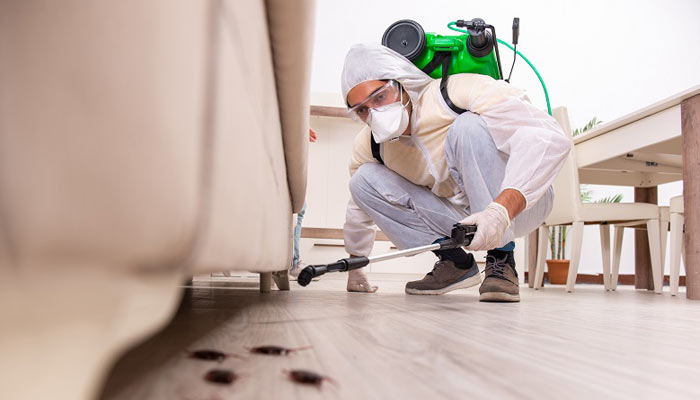Eco-Friendly Pest Control Homestead Options for a Healthier Home
Eco-Friendly Pest Control Homestead Options for a Healthier Home
Blog Article
Discover the Keys of Insect Control: How It Functions and Refine Revealed
Bug control is a meticulous practice that entails a deep understanding of parasite actions, calculated planning, and precise implementation. From determining the source of infestations to executing tailored control measures, the procedure of pest control is a blend of science and strategy focused on maintaining an unified setting. The complexities of this process commonly remain veiled, shrouded in secret. Untangling the nuances behind reliable pest control introduces a world of organized methods and very carefully calculated actions that are necessary in combating and stopping pest-related issues.
Pest Behavior Recognizing
Understanding the intricate behaviors of insects is critical for reliable bug control monitoring. By diving right into the routines and patterns of different bugs, experts can establish targeted techniques to eliminate infestations and prevent future occurrences. The behavior of roaches, such as their choice for humid and dark atmospheres, overviews pest control professionals in figuring out where to focus therapy initiatives. Recognizing that rats are nighttime creatures aids in establishing up catches and baits throughout the most active hours. Additionally, understanding the reproductive cycles of insects like ants help in interrupting their colonies' development.
By remaining abreast of the most recent research on insect habits, bug control professionals can consistently improve their strategies and remain ahead of progressing parasite populations. Eventually, a deep understanding of bug behavior is a cornerstone of successful insect control management.

Evaluation and Identification Methods
Efficient parasite control management depends greatly on meticulous assessment and exact recognition approaches to accurately develop and examine invasions targeted eradication methods. Assessment entails a complete exam of the residential or commercial property to identify the degree of the bug trouble, recognize the sort of bug existing, and find possible access factors. This procedure may include visually examining typical hiding places, utilizing surveillance tools such as video cameras or traps, and assessing pest droppings or damages indications.
Recognition is a critical step that follows evaluation, as different pests need specific therapy methods. Bug control experts use their know-how and knowledge of bug behavior to determine the varieties present accurately.
Insect Control Actions Implementation
Having actually thoroughly checked and properly recognized the insects present, the following important action is the implementation of targeted bug control procedures to efficiently eradicate the invasion. Chemical therapies include the use of pesticides to remove parasites, while biological controls present all-natural predators to manage bug populaces.
Correct execution of pest control procedures calls for competence to ensure the security of citizens and the setting. By employing targeted insect control procedures, problems can be successfully removed, developing a much healthier and pest-free environment.
Ecological Influence Factors To Consider
Mindful assessment of the prospective environmental effect is an important element when applying insect control steps. Bug control techniques can have different impacts on the setting, consisting of non-target varieties being impacted, contamination of dirt and water sources, and disturbance of the community. It is necessary to consider these factors to reduce any negative consequences on the atmosphere.
To reduce environmental impacts, integrated parasite monitoring (IPM) methods you can try these out are frequently recommended. IPM focuses on making use of a mix of strategies such as biological control, habitat adjustment, and the targeted use chemicals as a last hope. Pest Control Homestead. By utilizing an alternative method, IPM intends to regulate parasites properly while lessening damage to the setting

Ongoing Tracking and Prevention
Constant tracking and prevention play crucial functions in keeping effective parasite control techniques in time. As soon as initial insect control measures have been applied, continuous monitoring ends up being important to track bug activity degrees and make certain that the chosen techniques are functioning efficiently. Routine inspections by trained experts permit the early detection of any kind of signs of insect revival, allowing quick activity to be taken before the problem intensifies.
Preventive procedures are just as vital in maintaining a pest-free atmosphere. Carrying out approaches such as securing access points, maintaining cleanliness, proper waste administration, and lowering resources of food and water rob insects of the fundamentals they require to prosper. By proactively resolving these aspects, the chance of a parasite problem is considerably minimized.
Additionally, safety nets contribute to the long-term success of parasite control initiatives, decreasing the demand for responsive therapies and associated costs. By including recurring surveillance and prevention into an extensive parasite administration plan, individuals and companies can effectively safeguard their residential properties against undesirable intruders.
Conclusion
To conclude, parasite control entails understanding bug behavior, conducting extensive inspections, implementing control go right here actions, considering environmental impacts, and keeping ongoing monitoring and avoidance. By following these actions, bug invasions can be successfully taken care of and regulated. It is vital to take a proactive strategy to pest control to shield both human health and wellness and the environment.
By remaining abreast of the most recent study on pest habits, bug control experts can continually fine-tune their approaches and stay in advance of developing parasite populations.Having diligently examined and properly identified the bugs existing, the next important step is the application of targeted parasite control measures to successfully get rid of the problem.Additionally, picking ecologically friendly parasite control products and methods can dramatically minimize the ecological footprint of insect management methods - Pest Control Homestead. Once first insect control actions have been he said carried out, recurring monitoring ends up being crucial to track insect task degrees and make certain that the picked approaches are working efficiently.In conclusion, bug control includes understanding bug habits, carrying out thorough assessments, applying control actions, taking into consideration environmental effects, and preserving ongoing monitoring and prevention
Report this page